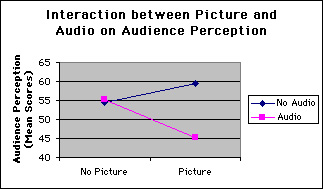Media Effects Research Lab - Research Archive
Perceptual effects of modality in on-line news
Student Researcher(s)
Rebecca Edgar (B.A. Candidate);
Faculty Supervisor
INTRODUCTION
While technological advances have altered and transformed existing modes of communication, the question about the different effects of these modes still remains unclear. Research has documented positive effects by demonstrating that humans readily form relationships with multimedia computers by perceiving them to be more human-like than other traditional means of communication. Other researchers have documented negative effects by showing that modality alone is not sufficient to positively alter information and knowledge transfer. The present study attempts to contribute further to this body of research by examining the effects of modality on audience perceptions of news content viewed through an on-line news website.
METHOD
Sixty participants took part in a between-participants experiment. After participants were seated in front of a computer terminal, they were asked to switch on the monitor and go through the website that came up. Five sessions were run where each group of participants received a different condition of modality: text only, text with pictures, text with audio, text with audio and pictures, and text with video and pictures. The same news stories were displayed regardless of the modality assigned to the particular condition. After browsing through the website, participants were asked to fill out a questionnaire that included measures of their perceptions of the news content, as well as some control measures.
RESULTS
The dependent measure of audience perception was divided into two factors called 'Quality' and 'Credibility.'
Participants in the text only condition perceived the quality of content to be lower than did participants in the text and picture condition but higher than participants in both the audio and video conditions. Further, in analyzing the interaction effects between picture and audio, the results suggest that the combined effect of these two modalities results in lower perceptions of quality. Thus, while the picture alone did not negatively affect quality perceptions, the introduction of audio, in conjunction with the picture, negatively affected perceptions.

CONCLUSIONS
There are two possible explanations for the findings reported above. First, partcipants' unfamiliarity with the combination of video-audio may have turned them off to the messages being conveyed through the site resulting in perceptions of lower quality. Second, the audio and video downloads may have acted as distractors to the overall content of the page. The results are of importance to both the news industry as well as website developers since they suggest that a combination of audio and video is detrimental towards the overall perception of the website.
For more details regarding the study contact
Dr. S. Shyam Sundar by e-mail at sss12@psu.edu or by telephone at (814) 865-2173

